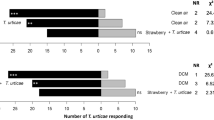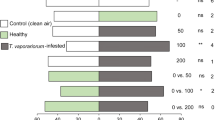Abstract
A standard essential oil mixture (SEOM) was formulated containing volatile compounds in the relative proportions found in the essential oil of the foliage of “Citation,” a strawberry cultivar relatively resistant toTetranychus urticae. Other mixtures contained varied levels, relative to the SEOM, oftrans-2-hexen-1-ol, nonanal, α-terpineol, and methyl salicylate. The behavior ofT. urticae females in response to these mixtures at several concentrations in propylene glycol was studied in choice tube (preference) tests. Feeding effects were measured by incorporating the mixtures and individual components into sucrose with32P. In the choice tube tests, mites were generally attracted by mixtures at concentrations of 0.1% or below unless the level of methyl salicylate was below 0.5 × that in the SEOM, or the level of nonanal was above that of the SEOM. When mixtures were incorporated into food, methyl-salicylate-stimulated feeding and nonanal levels were inversely related to the amount of food ingested.
Similar content being viewed by others
References
Chaplin, C.E., Stoltz, L.P., andRodriguez, J.G. 1968. The inheritance of resistance to the twospotted spider mite,Tetranychus urticae Koch in strawberries.Proc. Am. Soc. Hortic. Sci. 92:376–80.
Dabrowski, Z.T. andRodriguez, J.G. 1971. Studies on resistance of strawberries to mites. 3. Preference and nonpreference responses ofTetranychus urticae andT. turkestani to essential oils of foliage.J. Econ. Entomol. 64(2):387–391.
Dabrowski, Z.T., Rodriguez, J.G., andChaplin, C.E. 1971. Studies in the resistance of strawberries to mites. IV. Effect of season on preference or nonpreference of strawberries toTetranychus urticae.J. Econ. Entomol. 64(4):806–809.
Ekka, Irma, Rodriguez, J.G., andDavis, D.L. 1971. Influence of dietary improvement on oviposition and egg viability of the mite,Tetranychus urticae.J. Insect Physiol. 17:1393–1399.
Esau, K. 1967.Plant Anatomy. John Wiley and Sons, Inc., New York.
Kemp, T.R., Stoltz, L.P., Smith, W.T., Jr., andChaplin, C.E. 1968. The composition of the essential oil of leaves of strawberry cultivar “Citation”.Proc. Am. Soc. Hortic. Sci. 93:334–339.
Poe, S.L. 1973. Suppression with acaricides of twospotted spider mite populations on Florida strawberries.J. Econ. Entomol. 66(2):490–492.
Rodriguez, J.G., Chaplin, C.E., Stoltz, L.P., andLasheen, A.M. 1970. Studies on resistance of strawberries to mites. I. Effects of plant nitrogen.J. Econ. Entomol. 63:1855–1858.
Rodriguez, J.G., Dabrowski, Z.T., Stoltz, L.P., Chaplin, C.E., andSmith, W.O., Jr. 1971. Studies on resistance of strawberries to mites. 2. Preference and nonpreference responses ofTetranychus urticae andT. turkestani to water-soluble extracts of foliage.J. Econ. Entomol. 64(2):383–387.
Shanks, C.H., Jr. andBarrett, B.H. 1975. Resistance of strawberries to the twospotted spider mite.J. Econ. Entomol. 68(1):7–10.
Author information
Authors and Affiliations
Rights and permissions
About this article
Cite this article
Rodriguez, J.G., Kemp, T.R. & Dabrowski, Z.T. Behavior ofTetranychus urticae toward essential oil mixtures from strawberry foliage. J Chem Ecol 2, 221–230 (1976). https://doi.org/10.1007/BF00987745
Received:
Revised:
Issue Date:
DOI: https://doi.org/10.1007/BF00987745




